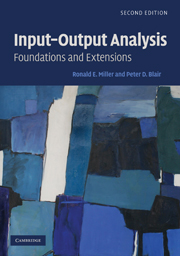Book contents
- Frontmatter
- Contents
- List of Figures
- List of Tables
- Preface
- 1 Introduction and Overview
- 2 Foundations of Input–Output Analysis
- 3 Input–Output Models at the Regional Level
- 4 Organization of Basic Data for Input–Output Models
- 5 The Commodity-by-Industry Approach in Input–Output Models
- 6 Multipliers in the Input–Output Model
- 7 Nonsurvey and Partial-Survey Methods: Fundamentals
- 8 Nonsurvey and Partial-Survey Methods: Extensions
- 9 Energy Input–Output Analysis
- 10 Environmental Input–Output Analysis
- 11 Social Accounting Matrices
- 12 Supply-Side Models, Linkages, and Important Coefficients
- 13 Structural Decomposition, Mixed and Dynamic Models
- 14 Additional Topics
- Appendix A Matrix Algebra for Input–Output Models
- Appendix B Reference Input–Output Tables for the United States (1919–2006)
- Appendix C Historical Notes on the Development of Leontief's Input–Output Analysis
- Author Index
- Subject Index
2 - Foundations of Input–Output Analysis
Published online by Cambridge University Press: 05 June 2012
- Frontmatter
- Contents
- List of Figures
- List of Tables
- Preface
- 1 Introduction and Overview
- 2 Foundations of Input–Output Analysis
- 3 Input–Output Models at the Regional Level
- 4 Organization of Basic Data for Input–Output Models
- 5 The Commodity-by-Industry Approach in Input–Output Models
- 6 Multipliers in the Input–Output Model
- 7 Nonsurvey and Partial-Survey Methods: Fundamentals
- 8 Nonsurvey and Partial-Survey Methods: Extensions
- 9 Energy Input–Output Analysis
- 10 Environmental Input–Output Analysis
- 11 Social Accounting Matrices
- 12 Supply-Side Models, Linkages, and Important Coefficients
- 13 Structural Decomposition, Mixed and Dynamic Models
- 14 Additional Topics
- Appendix A Matrix Algebra for Input–Output Models
- Appendix B Reference Input–Output Tables for the United States (1919–2006)
- Appendix C Historical Notes on the Development of Leontief's Input–Output Analysis
- Author Index
- Subject Index
Summary
Introduction
In this chapter we begin to explore the fundamental structure of the input–output model, the assumptions behind it, and also some of the simplest kinds of problems to which it is applied. Later chapters will examine the special features that are associated with regional models and some of the extensions that are necessary for particular kinds of problems – for example, in energy or environmental studies or as part of a broader system of social accounts.
The mathematical structure of an input–output system consists of a set of n linear equations with n unknowns; therefore, matrix representations can readily be used. In this chapter we will start with more detailed algebraic statements of the fundamental relationships and then go on to use matrix notation and manipulations more and more frequently. Appendix A contains a review of matrix algebra definitions and operations that are essential for input–output models. While solutions to the input–output equation system, via an inverse matrix, are straightforward mathematically, we will discover that there are interesting economic interpretations to some of the algebraic results.
Notation and Fundamental Relationships
An input–output model is constructed from observed data for a particular economic area – a nation, a region (however defined), a state, etc. In the beginning, we will assume (for reasons that will become clear in the next chapter) that the economic area is a country. The economic activity in the area must be able to be separated into a number of segments or producing sectors. These may be industries in the usual sense (e.g., steel) or they may be much smaller categories (e.g., steel nails and spikes) or much larger ones (e.g., manufacturing).
- Type
- Chapter
- Information
- Input-Output AnalysisFoundations and Extensions, pp. 10 - 68Publisher: Cambridge University PressPrint publication year: 2009
- 8
- Cited by

